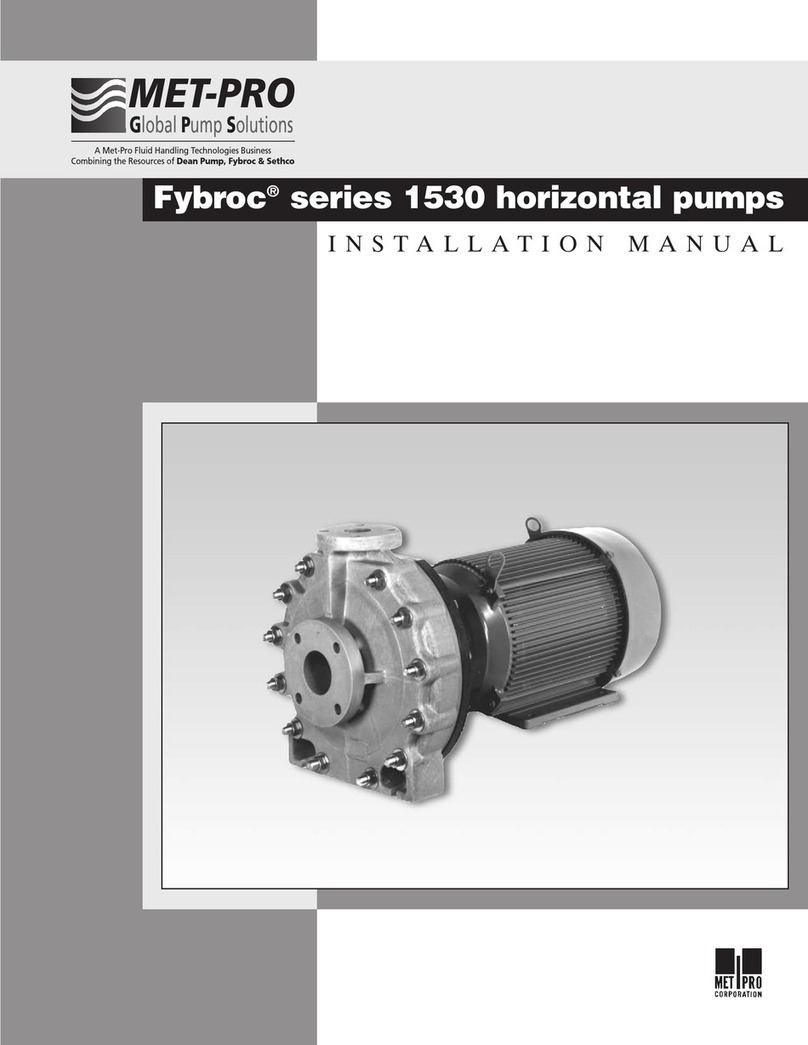
PIPING THE PUMP
Piping must not be connected to the pump until
base, pump, and driver are initially aligned, failure
to do so may result in the inability to attain proper
alignment later.
WARNING: ALL FLANGED CONNECTION TO
THE PUMP HOULD BE FULL FLAT FACE WITH
FULL CONTACT GA KET . RAI ED FACE
FLANGE OR PARTIAL CONTACT GA KET
HOULD NOT BE U ED A EXCE IVE
TRAIN CAN BE APPLIED TO THE PUMP
FLANGE UPON TIGHTENING.
The pump has been designed with all necessary
strength factors for long, reliable service life. How-
ever, due to the composite construction, care must
be taken during installation to avoid unnecessary
pipe strain. If severe piping strains are to be en-
countered, flexible connections are recommended
in the suction and discharge pipe lines. When lined
piping is used, flange alignment should be carefully
checked. Spacer ring gaskets are recommended to
assure parallel alignment of pipe and pump
flanges. The following flange bolt torque
values should be used:
All piping must be supported independently of the
pump. The piping should always line up naturally
with the pump flanges. Never draw the piping to the
suction or discharge flanges of the pump. Outside
installations should be properly compensated for
changes in ambient temperatures. Refer to pipe
manufacturers standards for proper installation.
Omission of this could result in severe strain
transmitted to the pump flanges.
The piping should be as short and direct as possible.
Avoid all unnecessary elbows, bends and fittings, as
they increase friction losses in the piping.
UCTION PIPING
A) To minimize friction loss, the length of the suction
pipe (from process to pump inlet) should be as
short as possible. It is important that NPSH
available to the pump is greater than the
NPSH required by the pump, long suction runs
greatly affect NPSH and should be considered
carefully. See pump performance curve for
NPSH requirements.
B) The diameter of the suction pipe should be
as large as the pump suction. If long suction
runs are encountered, the suction pipe
diameter should be increased to reduce the
NPSH required.
C) Increasers or reducers, if used, should be
eccentric and installed with the eccentric side
on the bottom of the pipe to prevent air traps.
D) Elbows, fittings, valves or expansion joints
should be avoided at the suction flange. Allow
a straight run of at least 10 pipe diameters into
the suction of the pump.
E) If a valve is to be installed in the suction piping,
only full flow valves offering a minimum flow
disturbance should be used (ball, plug types).
These valves should be for shut-off only when
the pump is not running, and not for throttling
or controlling flow. Centrifugal pumps should
never be throttled on the suction side.
F) Provisions for a suction pressure gauge should
be included.
DI CHARGE PIPING
A) Installation of a valve in the discharge line that
can be used as a block for inspection and
maintenance is recommended. It should be of
a design to allow throttling or flow control.
B) The diameter of the discharge pipe should be
as large or larger than the pump discharge.
C) Provision for a discharge pressure gauge
should be included.
ANCILLARY PIPING
A) The diameter of the ancillary or seal piping
should be large enough to meet the seal flush-
ing requirements. Typically this is 1/4-1/2 GPM
at a pressure of 15-25 PSI above the suction
pressure for most mechanical seals. Refer to
pages 25 and 26 for recommended seal flush
flow rates and piping installations.
B) Where the ancillary piping is connected to the
pump only plastic fittings shall be used.
Flange ize Bolt Torque
1 1/2” 9-12 ft-lbs
2” 18-24 ft-lbs
3” 23-30 ft-lbs
4” 27-36 ft-lbs
6” & Larger 35-50 ft-lbs
5
























